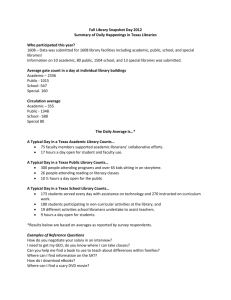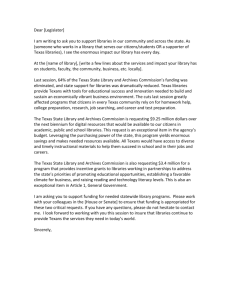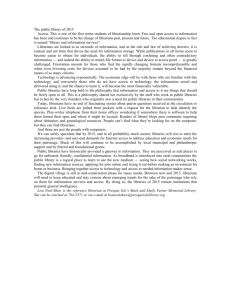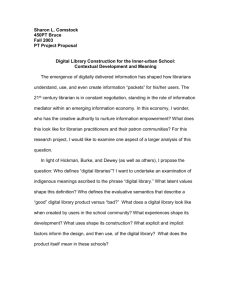LEARNING MEDIA - Texas Library Association
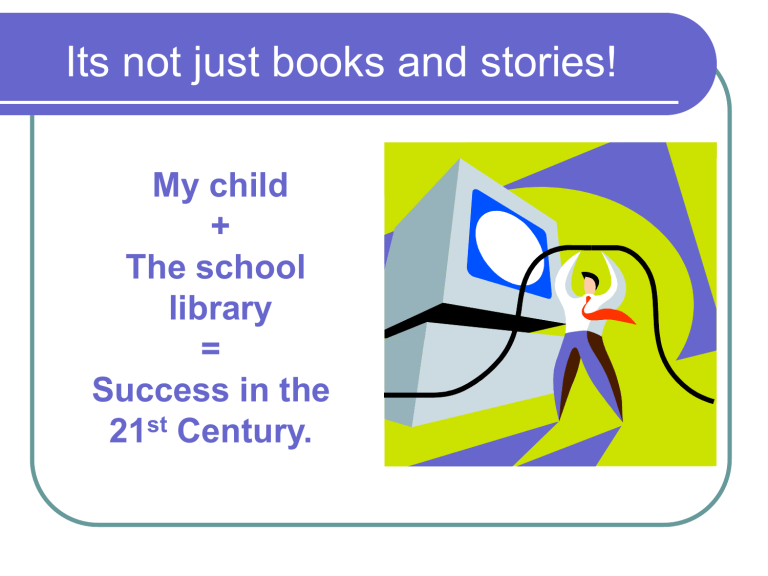
Its not just books and stories!
My child
+
The school library
=
Success in the
21 st Century.
Texas Standards for School Libraries:
Texas has best practices that are to benchmarks to help design, implement, measure and improve an effective library program.
Texas Library Standards require:
access to materials in all formats at point of need;
assistance to classroom teachers in the design of learning experiences to meet student needs;
learning experiences based on relevance and
21 st Century Learning
Skills.
The school library program is
…
Critical in the teaching and learning process as an information source and content area.
Translation 21
st
Century Skills are:
not an add-on
not enrichment
apply to all subject areas
life skills each student must master to learn independently and work successfully.
Texas State Model of School Libraries...
Title 12. Cultural Resources. Part I. Chapter 4 Standards
“ offer education, training, and guidance to students and staff in the use of information technology resources.”
Translation:
fully integrated into instruction, providing skills to access information and ideas.
Translation:
20 years of research on effective teaching practice tell us: teaching skills in isolation is ineffective; provides no long term retention.
Texas State Model of School Libraries...
Title 12. Cultural Resources. Part I. Chapter 4 Standards
“provides relevant, meaningful instruction based on multiple resources.”
Translation:
20 years of research on effective teaching practice tell us: information literacy and problem solving skills must occur within content areas and as part of relevant and real world experiences.
The school library program is…
administration, library media specialist, students, and teachers work as a team to ensure that the program positively contributes to the learning process.
Translation:
Best practice requires collaborative planning between classroom teachers and school librarians.
School Librarian is a teacher first and should be part of grade level and department planning.
Texas State Model of School Libraries...
Title 12. Cultural Resources. Part I. Chapter 4 Standards
“ applies an information problem-solving process to curriculumrelated learning objectives.”
The school library program is
…
a discovery learning lab that uses traditional resources and new technologies as standard teaching and learning tools.
Translation:
not abandoning print material;
providing digital resources;
providing instruction in location, analysis and evaluation of info in all media;
Multiple literacy skills .
The school library program is…
Based around a convenient, comfortable, and aesthetically inviting location with necessary furnishings and tools.
Translation
has the equipment, electrical and data resources needed to serve student learning needs;
is an inviting and user friendly facility;
can accommodate individual and group learning ;
Provides a variety of media for discovery learning and problem solving.
Texas State Model of School Libraries...
Title 12. Cultural Resources. Part I. Chapter 4 Standards
“serves as an information center that provides...
flexible access to resources and technologies, fully integrated into the instructional process.”
Translation:
Students, classes and teachers can get to the library when they need it, not just on an appointed day and time.
The school library program is…
a partnership with teachers to foster and support a love of reading and pursuit of knowledge in its many forms and media
.
Translation
The library media center and its staff exist to support instruction, student learning and the pursuit of knowledge through print, video, audio, electronic media, and collaboration.
Texas State Model of School Libraries...
Title 12. Cultural Resources. Part I. Chapter 4 Standards
“encourages and provides opportunities for collaborative planning and teaching by librarians and teachers.”
National Standards for the
21 st Century Learner support
inquiry,
critical thinking,
applying knowledge,
developing informed decisions,
creating new knowledge
ethical use of information,
personal growth.
On-line tools for Texas students:
Magazine database
Encyclopedia Britannica
(three levels and in
Spanish)
Available from any computer with internet connection
How do we get it all done?
relevant instruction,
multiple resources,
information problem solving,
application to authentic real world experience,
collaboration,
evaluation of sources,
What does the research say?
Library activities that impact student performance and higher test scores:
Planning with teachers;
teaching collaboratively with teachers;
training teachers to use tech more effectively.
What does the research say?
L ibraries with only a librarian rarely perform collaborative, curriculum or integration activities.
What does the research say?
Schools without librarians are lower performing on
TAAS than schools with librarians.
What does the research say?
Libraries with library aides only, instruction and 21 st
Century skills activities are not being performed because library aides are not trained to perform them.
What does the research say?
For libraries to have the greatest impact on student performance, libraries need to be staffed, at minimum, with both a librarian and an aide.
- Texas Study
What does the research say?
Libraries staffed with librarians and aides associated with
increased library use,
more visits to the library by individual students,
more literacy skills instruction,
more books and materials checked out.
Texas Study
What does the research say?
Test scores tend to be higher for all types of schools where there Is a school librarian.
- Alaska Study
What does the research say?
Test scores tend to be higher for all types of schools where library staff spend more time:
delivering library/information,
literacy instruction to students,
collaborating with teachers on instructional units,
training teachers in information access.
- Alaska Study
What does the research say?
Test scores tend to be higher for all types of schools where the library:
is open longer hours,
has a cooperative relationship with the public library,
provides online access to information via the Internet.
-Alaska Study
What does the research say?
Schools with well-developed library media programs average 10%-18% higher reading scores.
- Colorado Study
What does the research say?
When librarians collaborate with classroom teachers, reading scores increase 8% -
21%.
- Colorado Study
What does the research say?
When students can use the library as needed, reading scores improve 13-22%.
- Colorado Study
What does the research say?
When students can access library resources using the
Internet, reading scores rise
6%-25%.
- Colorado Study
What does the research say?
Reading scores increase with increases :
in integration of information literacy with the curriculum,
in time spent by school librarians teaching cooperatively with teachers,
teaching information literacy independently.
- Pennsylvania Study
What does the research say?
Reading scores increase with increases in:
providing in-service training to teachers,
serving on standards committee,
serving on curriculum committee,
managing information technology.
- Pennsylvania Study
What’s the result?
An effective library program helps develop
Analytic skills,
Thinking across subjects,
Problem solving skills,
Divergent thinking,
Independent learners,
Leadership and condence.
References
American Association of School Librarians. (2007).
Standards for the 21 st -Century Learner . Chicago, IL:
American Library Association.
Lance, Keith Curry, et al. (2000). How school libraries help kids achieve standards: The second Colorado
Study . San Jose, CA: Hi Willow Research and
Publishing.
Lance, Keith Curry, et al. (2000). Information empowered: The school librarian as an agent of academic achievement in Alaska schools. San Jose,
CA: Hi Willow Research and Publishing.
Lance, Keith Curry, et al. (2000). Measuring up to standards: The impact of school library programs & information literacy in Pennsylvania schools.
San Jose, CA: Hi Willow Research and Publishing.
Smith, Ester G. (2001). Texas school libraries: Standards, resources, services, and students’ performance.
EGS Research and Consulting.
Texas State Library and Archives Commission. (2005).
School Library
Programs: Standards and Guidelines for Texas , revised. Texas
Administrative Code, Title 13. Cultural Resources, Part I. Texas State
Library and Archives Commission, Chapter 4. School Library Programs,
Subchapter A. Standards and Guidelines, Section 4.1. Austin, TX: Texas
State Library and Archives Commission.
